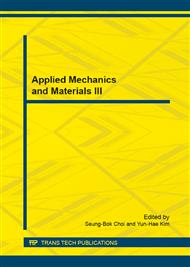p.271
p.279
p.285
p.290
p.299
p.309
p.313
p.317
p.322
Experimental Study on Dynamic Responses of a New Type of Debris Flow Dam under Solid Impact Load
Abstract:
Dams can effectively alleviate great debris flow hazards to downstream regions, so they has been widely applied to prevention and control engineering of debris flow disaster now. A kind of steel-concrete combined structure with steel braces was presented based on conventional gravity dams, and the superiority of the new structure in terms of impact resistance was verified contrastively by means of model experiments under solid impact. The results show that braces can restrain cracks and reduce their width, thus the extent of damage in impact areas is alleviated effectively. Compared with the conventional dam, the dynamic strains and acceleration peak values of the dam with braces both observably reduce, and the highest reduction ranges of them may be up to 69.2% and 47.8% respectively, so the deformation and vibration are limited by the braces. The dynamic displacement peak values of the new-type dam are significantly less than the conventional dam, and the average reduction range of this index can reach to about 46%, so the structural stiffness has been enhanced by a large margin.
Info:
Periodical:
Pages:
299-308
Citation:
Online since:
January 2015
Authors:
Price:
Сopyright:
© 2015 Trans Tech Publications Ltd. All Rights Reserved
Share:
Citation:


